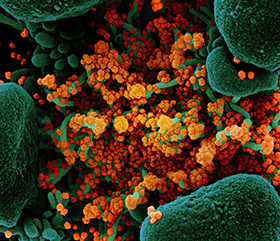Radical Approaches to COVID-19 Testing and Surveillance
NIDCR supports six grants and six supplements, listed below, as part of NIH’s Rapid Acceleration of Diagnostics Radical (RADx-rad) initiative, which encourages development of nontraditional approaches to address gaps in COVID-19 testing and surveillance. The NIDCR-supported projects will explore various ways of detecting SARS-CoV-2, including a “smart mask” that changes color when exposed to the virus, electronic-noses to “sniff out” the virus, and several grants to small businesses and institutes to develop a breathalyzer or other methods to rapidly and affordably detect SARS-CoV-2 in saliva or the mouth. Read the NIH press release about the new RADx-rad awards.
A Multimodal Platform for Oral Screening of COVID-19
Innotech, LLC
This project will develop a multiplexed sensor platform based on nanomaterials capable of rapid simultaneous detection of multiple components of viral particles in a field applicable electrochemical device. The device has synthetic biosensors that, in a multimodal, rapid, accurate, inexpensive, field- deployable test, will detect SARS-CoV-2. Learn more on NIH RePORTER.
A Rapid Breathalyzer Diagnostics Platform for COVID-19
Rutgers University
This project will develop a novel testing platform that detects SARS-CoV-2 virions in a patient’s breath. The technology captures exhaled breath into the COVID breathalyzer, where droplets and other emitted particles captured by a liquid-membrane scrubber are retrieved by a microfluidic chip designed to detect the presence of SARS-CoV-2 virus.
A Rapid Saliva Antigen Test for SARS-CoV-2 Detection
Brigham and Women’s Hospital
This project will develop an ultrasensitive point of contact antigen-based diagnostics for the detection of SARS-CoV-2 by uniquely combining nanotechnology, low-cost optical sensing, and machine learning.
A SARS-CoV-2 Breathalyzer for Direct Virus Detection
Aerosol Devices, Inc
This project will develop and test a novel breathalyzer for detecting aerosolized SARS-CoV-2 directly from exhaled breath in near real-time by marrying a proven, cutting-edge aerosol sampling technology with a novel and inexpensive virus detector. Aersol Devices Inc will modify its commercial bioaerosol collector, which is used to sample from the ambient environment, to enable it to collect viruses from breath samples into a concentrated liquid sample. Learn more on NIH RePORTER.
A Scalable Aptamer-based Electrochemical Biosensor for Rapid Detection of SARS-Cov-2 from Saliva
mPOD, Inc.
This project will expand COVID-19 testing capabilities through a novel biosensor that will use oligonucleotide molecules called aptamers to bind to unique sites on the SARS-CoV-2 virus in saliva and report the data via the mPOD Inc. mobile app. The study team hypothesizes that mPOD will improve point-of-care and over-the-counter testing capacity for COVID-19 and will further enhance tracking through a rapid, affordable, aptamer-based biosensor. Learn more on NIH RePORTER.
Broad-spectrum Detection of VOC and Non-VOC Biomarkers from Patient Exhalant using Biomimetic Multiplexed eNose Biosensor for COVID-19 Diagnosis
University of Washington
This project will develop a biomimetic olfaction-and gustation-based sensors for detecting volatile organic compound biomarkers against SARS-CoV-2 that also incorporate detection of biomarkers of protein and nucleic acid origin.
Direct Bioelectronic Detection of SARS-Cov-2 from Saliva using Single-molecule Field-effect Transistor Array
Quicksilver Biosciences, Inc.
This project will develop a new bioelectronic approach for antigen testing for COVID-19. The study will utilize DiagnostikosTM, an in-development rapid point of contact platform for direct, real- time, multiplexed, quantitative bioelectronic detection of biomolecules that employs an all-electronic detection device that functions at the single-molecule level. Learn more on NIH RePORTER.
Designer DNA Nanostructure Based Biosensing for Rapid COVID-19 Detection and Monitoring using Saliva Sample
Atom Bioworks, Inc.
This project will develop a DNA Star aptamer-based detection system that can cheaply and readily detect SARS-CoV-2 in saliva samples. The novel DNA Star biosensing approach utilizes viruses unique expression of spatial patterns of antigens on their surfaces, facilitating multivalent binding to host cells for infection. Learn more on NIH RePORTER.
MOF-SCENT: Metal-organic Frameworks for Screening COVID-19 by Electronic-Nose Technology to Improve Selectivity and Time Response
Missouri University of Science and Technology
This project will develop a collection of identical electromagnetic sensors, each equipped with a distinct metal-organic frameworks (MOFs) material that can identify volatile organic compounds that indicates the COVID-19 disease.
RADx-rad: A Rapid, Sensitive, Point-of-care, Antigen-based Diagnostics for SARS-CoV-2
Boston Biomedical Innovation Center (B-BIC)
This project will develop a simple, low-cost, rapid saliva-based test using test strips that incorporate novel high affinity SARS-CoV-2 binder nanodiscs. The study aims are focused on producing and optimizing the test strip components and performing a feasibility study on archived patient samples.
Validation of Smart Masks for Surveillance of COVID-19
University of California, San Diego
This project will develop a “smart mask” that changes colors when exposed to COVID-19-related proteases (Mpro and PLP proteases specific to the SARS viruses) found in saliva; the mask concentrates them from aerosolized saliva when the subject breathes and speaks. Biobank saliva samples are being leveraged to help determine the specificity of the mask. Learn more on NIH RePORTER.
Virus Counter: Rapid and Sensitive Diagnostics Based on Digital Detection of Individual Pathogens
Boston University
This project will customize an established virus detection system that has already shown the ability to detect viruses such as Ebola and Marburg viruses to develop a focused assay for SARS-CoV-2.

